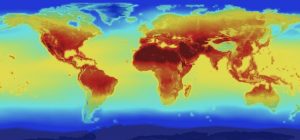Signature of the Paris Agreement on climate change: what consequences for the mountains?
On 22 April 2016 (Earth Day), 177 members of the United Nations Framework Convention on Climate Change (UNFCCC) signed the Paris Agreement on greenhouse gases emissions mitigation, adaptation and finance. What can be expected by the mountains areas with the enforcement of this agreement?
 It must be recalled that mountains are particularly sensitive to climate change, notably with the melting of glaciers and high altitude snow. Jean Jouzel, Vice President of the Scientific Panel of the Intergovernmental Panel on Climate Change (IPCC) from 2002 to 2015 and member of the Strategic Research Council since 2014, recalls that if the targets of the Paris Agreement were not reached, a warming from 4 to 5 degrees Celsius by the end of the century can result. Should this happen, all the glacier below 4,000 m would disappear. It can also be foreseen that the snow will be strongly missing to the low and medium altitude of the mechanized ski resorts, affecting tourism but also water resources and hydropower potential. The decrease in biodiversity would be accelerated, resulting in the disappearance of some species. Landslides will also be more frequent.
It must be recalled that mountains are particularly sensitive to climate change, notably with the melting of glaciers and high altitude snow. Jean Jouzel, Vice President of the Scientific Panel of the Intergovernmental Panel on Climate Change (IPCC) from 2002 to 2015 and member of the Strategic Research Council since 2014, recalls that if the targets of the Paris Agreement were not reached, a warming from 4 to 5 degrees Celsius by the end of the century can result. Should this happen, all the glacier below 4,000 m would disappear. It can also be foreseen that the snow will be strongly missing to the low and medium altitude of the mechanized ski resorts, affecting tourism but also water resources and hydropower potential. The decrease in biodiversity would be accelerated, resulting in the disappearance of some species. Landslides will also be more frequent.
If enforced, the Paris Agreement will begin to give results only in the second half of this century. Before that, mountain areas will have to participate to the common efforts. In this context, a number of stakeholders seem not to have understood that the massive installation of snow production equipement in mechanized ski resorts is a headlong rush. These equipments, besides contributing to the global warming, are, short-term, condemned by the elevation of the winter temperatures.
The Paris Agreement highlights the importance of land-based carbon sinks. Among them, natural forests in mountain areas must be protected, by halting deforestation and reducing degradation.
(HT)